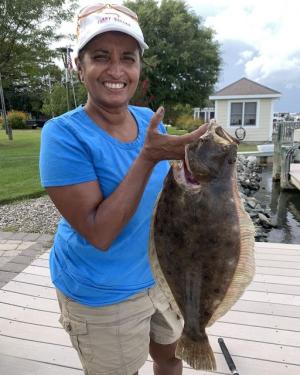The Mid-Atlantic Fishery Management Council met Aug. 8-11 in Annapolis, Md. During this meeting, the council set the Recreational Harvest Limit for summer flounder, scup (porgies), black sea bass and bluefish.
The RHL for summer flounder in 2023 was 10.62 million pounds. That figure will drop to 6.35 million pounds in 2024. That is almost a 50% decrease in the one fishery that provided good action all year for Delaware charter and private boats. Exactly how that will play out has yet to be decided. If it goes as it has in the past, Delaware, Maryland and Virginia will meet and come up with the same regulations. They could decrease the number of fishing days, as they did with black sea bass this year. They could increase the minimum size back to 17 inches or even higher. Or they might decrease the bag limit to three fish or fewer. Whatever they decide, it will have a chilling effect on the fishing industry.
Right now, charter boats are getting $200 to $250 for a trip with the possibility of taking home four flounder over 16.5 inches. Any reduction in the bag limit would certainly have customers considering if three flounder would be worth that much money.
A reduction in the number of days we would be allowed to fish for flounder would mean a reduction in the number of days the for-hire fleet can earn a living. While they could fish for other species like sea bass, dolphin or triggerfish, flounder are the most sought after species.
These drastic changes have come about because the council and board determined that while the summer flounder stock was not overfished, overfishing was occurring. They also determined that fishing mortality was slightly underestimated, while the stock biomass has been overestimated. In addition, stock recruitment has been below average since 2011, and the high estimate for 2018 has been revised downward to recent below-average levels with new assessment results.
On the other hand, NOAA Fisheries has released a paper admitting their mail survey sent to fishermen from Maine to Mississippi and used to determine fishing effort is not accurate. The product from this survey is used in the development of the Marine Recreational Informational Program. Since the survey produced bad results, it stands to reason that the MRIP was bad data. They admit as much, but they also say while it is bad data, it is still the best available and therefore will continue to be used to set regulations for summer flounder, black sea bass, scup and bluefish.
While the vast majority of scup (porgies) are caught to our north, they will be the least affected by the new regulations. The 2023 management track assessment found that scup were not overfished and overfishing was not occurring. Their RHL in 2023 was 9.27 million pounds and that will go up to 13.18 million pounds in 2024. Then in 2025, the RHL will drop back to 11.84 million pounds.
When it comes to black sea bass, the commercial sector received a 25% increase in quota to 6 million pounds, while the recreational sector took a 5% decrease from 6.57 million to 6.27 million pounds. An updated dead discard projection of each sector led to the change in quota and RHL.
Bluefish are not overfished and overfishing is not occurring. The stock is not fully rebuilt and remains under the council’s and commission’s approved seven-year rebuilding plan.
In 2024, the RHL will be 11.96 million pounds, down from 14.11 million in 2023. In 2025 the RHL will go back up to 15.70 million pounds. The current regulations are five fish per day for charter and head boats and three fish per day for those of us who fish from shore or private boats.
The Mid-Atlantic Fisheries Management Council and the Atlantic States Marine Fisheries Commission will meet again in December to work out seasons, bag limits and sizes for all four of these species. I doubt we will hear any good news.
Fishing report
Fishing has been decent in the ocean for flounder and sea bass. Anglers who know how to fish are catching limits of both species with flounder to 7 pounds, and at least one 5-pound sea bass caught out of Ocean City, Md. Boats working farther offshore are finding plenty of dolphin, and in the canyons, there are good numbers of tilefish. Several boats out of Cape May, N.J., have caught and released Grand Slams; blue marlin, white marlin and sailfish.
Closer to shore, sheepshead have been caught on sand fleas from the rocks at Indian River Inlet. The same fish are available from the Outer Wall, the Inner Wall and the Ice Breakers out of Lewes. Sand fleas have been the best bait for these fish.

























































